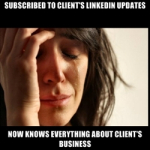Four LinkedIn Fails: Fix These Features Before Adding New Ones
- Janice Cuban

- Oct 25, 2012
- 3 min read
Updated: Jul 5, 2019
In my last blog, I wrote about how great LinkedIn is—and I stand by that. It is by far the best online business networking tool out there and has added many useful capabilities in 2012. Taking its cue from the best of social media and sporting a more user-friendly interface and page design, LinkedIn is on a roll. But as with everything, there is always room for improvement. Here are four annoying features LinkedIn should fix before continuing to add new products.
#1 Better Activity Notification System: From the beginning, LinkedIn’s notification system for recommendations, invitations to connect, or anything else is inordinately slow, giving a digital meaning to the phrase “snail mail.” Sometimes hours or days later I will receive an email about something I saw or had already done. I’m starting to wonder if they are using AOL mail servers. LinkedIn recently added a “Notifications” function on the home activity page so, when logged in, you can see updates (think Facebook red)—but even that feature has its quirks. Often after I view a new notification, it will still show up as new the next time I log in. Let’s get it right, people.
Impact: To be so s-l-o-w or unreliable turns off current members and won’t attract new folks, plus it’s not keeping pace with LinkedIn’s other improvements.
#2 Banish Free Anonymous Profile Viewing Privileges: As a non-paying LinkedIn member, I am entitled to see the names of up to five people who have viewed my profile each time I log in. But guess what? I don’t always see who they are: You can be anonymous when you view a profile or merely “Someone in X industry.” Is it a potential client? Cyber stalker? The Facebook and Twitter models allow you to visit a profile page without the person knowing. Ignorance is bliss in this case. I consider it OK to allow LinkedIn members to be “anonymous,” but only as part of the upgraded service. No pay, no anonymity. Conversely, when you have a paid subscription, you get to see everyone who has viewed your profile.
Impact: Seeing “A LinkedIn Member” view my profile (which used to be called “Anonymous LinkedIn Member,” which sounded even more weird) gives me the creeps. We have a right to know who is checking us out, or else don’t bother to tell us that someone is looking.
#3 Better Target Practice on Jobs and Groups: I could guess how LinkedIn’s algorithm works in order to inform me of who I might know, by connecting the dots with people who are 2nd and 3rd connections, but with Jobs and Groups it seems the system is out to lunch, or even drinks. Potential jobs that LinkedIn sends my way should be based on criteria such as my industry, location, etc. Too often, however, the jobs are geo-incorrect or just out of left field. Same with Groups. I’m still flummoxed by the continual recommendation to join the Florida Communication Professionals group (hmm…maybe someone in that group looked at my profile anonymously).
Impact: It is a waste of time for LinkedIn to suggest jobs or anything else that is not relevant to our careers, and reflects poorly given all the rich data that LinkedIn has on users.
#4 Better Customization of Settings: As with other social media, LinkedIn allows you to adjust settings such as privacy, but doesn’t allow customization of specific features. For instance, on your Activity Broadcast, it’s either all “On” or all “Off.” You’re stuck between no updates and being a potential over-poster. What if I want people to see who I am connected to, but not which companies I’m following? What if I want to post updates to Groups but not on the Activity Update? These are not options in the current system.
Impact: In an area as sensitive as career. where people are job-hunting and developing their professional and personal brand, these options should be available to allow users the most flexible options for presenting themselves.
So that’s my list of fixin’s. None of them are deal-breakers, but all of them have been noticed—some for a while now. I look forward to the new upgrades and enhancements that LinkedIn has in the works, but first let’s repair what’s already broken.







Comments